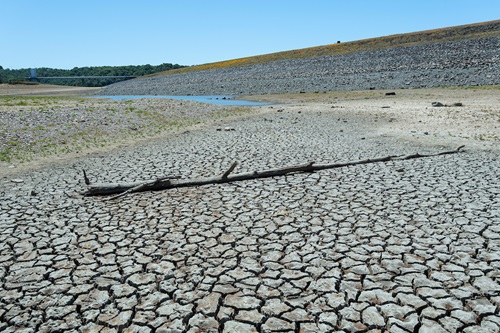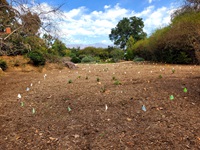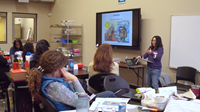Notice is hereby given that the California Department of Water Resources (DWR), as the Lead Agency of the Drought Resilience Interagency & Partners (DRIP) Collaborative, will host a series of workgroup meetings of the DRIP Collaborative in June 2025.
Drought

Dry conditions in the area of Lake Mendocino in Mendocino County. DWR/2021.
Visit drought.ca.gov for water shortage assistance and information on drought-related financial assistance.
California is no stranger to drought; it is a recurring feature of our climate. We recently experienced the 5-year event of 2012-2016, and other notable historical droughts included 2007-09, 1987-92, 1976-77, and off-and-on dry conditions spanning more than a decade in the 1920s and 1930s.
Paleoclimate records going back more than 1,000 years show many more significant dry periods. The dry conditions of the 1920s-30s, however, were on a par with the largest 10-year droughts in the much longer paleoclimate record.
Droughts cause public health and safety impacts, as well as economic and environmental impacts. Public health and safety impacts are primarily associated with catastrophic wildfire risks and drinking water shortage risks for small water systems in rural areas and private residential wells. Examples of other impacts include costs to homeowners due to loss of residential landscaping, degradation of urban environments due to loss of landscaping, agricultural land fallowing and associated job loss, degradation of fishery habitat, and tree mortality with damage to forest ecosystems.
Unfortunately, the scientific skill to predict when droughts will occur – which involves being able to forecast precipitation weeks to months ahead – is currently lacking. Improving long-range weather modeling capabilities is an area of much-needed research.
Defining Drought
Defining drought is based on impacts to water users. California is a big state and impacts vary with location. Hydrologic conditions causing impacts for water users in one location may not represent drought for water users in a different part of California, or for users with a different water supply. Individual water agencies may use criteria such as rainfall/runoff, amount of water in storage, or expected supply from a water wholesaler to define their water supply conditions.
Drought is a gradual phenomenon, occurring slowly over a period of time. Storage, whether in surface water reservoirs or in groundwater basins, buffers drought impacts and influences the timing of when drought impacts occur. A single dry year isn’t a drought for most Californians because of the state’s extensive system of water infrastructure and groundwater resources buffer impacts.
Drought impacts are felt first by people most dependent on annual rainfall – such as ranchers using dryland range or rural residents relying on wells in low-yield rock formations. Drought impacts increase with the length of a drought, as carry-over supplies in reservoirs are depleted and water levels in groundwater basins decline.
Provisions of California’s Emergency Services Act have been used to declare a statewide drought emergency for only two of our droughts, the 2012 to 2016 event and its immediate predecessor in 2007-09.
Current Water Conditions in California
Percent of Average Precipitation Water Year to Date
Departure from Average Temperature Water Year to Date
Comparison of Current Water Year Natural Flow to Drought WYs 2014 & 2015
Central Valley Project Water Allocations (Historical and Present)
State Water Project Allocations (Historical and Present)
Colorado River Reservoir Conditions, Lower Basin
Colorado River Reservoir Conditions, Upper Basin
On March 28, 2022, the Governor issued Executive Order N-7-22, which included the suspension under specific circumstances of the California Environmental Quality Act, also known as CEQA (Public Resources Code, Division 13 (commencing with section 21000)).
To qualify for the CEQA suspension, projects had to be consistent with Executive Order Action 13 requirements. Groundwater recharge projects had to occur on open and/or working lands, be funded by the Sustainable Groundwater Management Grant Program or be designated a Flood-Managed Aquifer Recharge project, and needed to offset or mitigate drought impacts on groundwater. Local agencies implementing recharge projects and seeking CEQA suspension were required to submit a Self-Certification Form to DWR for review and concurrence that the proposed activities were eligible under the Executive Order provisions.
See below for the list of projects that have received DWR concurrence for eligibility for the CEQA suspension, as directed by the Executive Order.
In light of improved hydrologic conditions, self-certification forms for DWR concurrence are no longer being accepted for this Executive Order CEQA suspension. We encourage you to explore statutory and/or categorical exemptions under CEQA that may be applicable to your project.
The following are the Approved Suspension Requests:
- North San Joaquin Water Conservation District: Multiple Recharge Sites
- Madera County: Recharge Project 1
- Madera County: Chowchilla Subbasin Recharge Project 2
- La Paloma Mutual Water Company: Bear Creek Ranch
- Aliso Water District: Chowchilla Bypass Project
- Colusa County Water District: Pilot Multi-Benefit Groundwater Recharge Project
- Dunnigan Water District: Dunnigan Recharge Area Program
- Westlands Water District: Pasajero Groundwater Recharge Project
- Consolidated Irrigation District: Multiple Recharge Basin Project
- Kings County Water District: Recharge Basins Project
- Kings River Conservation District: Kings River Channel Reclamation Project
- Corcoran Irrigation District: Flood Capture and Basin Recharge and Storage Project
- City of Visalia: Multi-Purpose Groundwater Recharge Project
- James Irrigation District: James Bypass Basins Storage and Recharge Project
- Sierra Vista Mutual Water Company: Sierra Vista Recharge Pond
- La Paloma Mutual Water Company: G Ranch Land Repurposing Project
- Root Creek Water District: In-Lieu Groundwater Recharge Project
- Sandy Mush Mutual Water Company: Subsidence Priority Area Project
- Triangle T Water District: Poso Pipeline Extension Project
- Tri-County Water Authority: Allensworth Project
- County of Fresno: 57-acre Recharge Facility
- Oakdale Irrigation District: Paulsell Lateral Expansion
- Alta Irrigation District Recharge Project
The State Water Resources Control Board has regulatory authority to review and approve all water rights permit applications, including the 180-day temporary water rights permits for groundwater recharge. DWR, in our assistance role, is working with GSAs that have identified applicable local groundwater recharge projects to facilitate the water rights permitting process. These projects are consistent with the Sustainable Groundwater Management Act (SGMA) and drought recovery strategies in the Governor’s “California Water Supply Strategy, Adapting to a Hotter, Drier Future.”
For more information on available regulatory assistance and eligibility, see our fact sheet on DWR’s regulatory assistance for temporary water rights for groundwater recharge.
- 2023 Operations Outlook – September
- 2023 Operations Outlook – August
- 2023 Operations Outlook – July
- 2023 Operations Outlook – June
- 2023 Operations Outlook – May
- 2023 Operations Outlook – April
- 2023 Operations Outlook – March
- 2023 Operations Outlook – February
- 2022 Operations Outlook – September
- 2022 Operations Outlook - August
- 2022 Operations Outlook - July
- 2022 Operations Outlook – June
- Updated 2022 Operations Outlook – June
- 2022 Observed Data & Operations Outlook - May
- 2022 Observed Data & Operations Outlook - April
- 2021 Observed Data & Operations Outlook - September
- 2021 Observed Data & Operations Outlook - August
- 2021 Observed Data & Operations Outlook - July
- 2021 Observed Data & Operations Outlook - June
- Small Community Drought Relief Program 2021 Guidelines:The Small Community Drought Relief program provides urgent financial and technical support to counties and communities in urgent need of drinking water supply assistance due to drought.
- Actions Pursuant to May 2021 Drought Emergency Proclamation Suspension of Specified Requirements
- Drought Emergency Proclamation July 8, 2021
- Drought Emergency Proclamation May 10, 2021
- Drought Emergency Proclamation April 21, 2021
- Efficacy Report 2015 Emergency Drought Barrier Project June 2019
- Leak Detection Assistance for Small Water Systems
- Water Transfers
- Urban Water Management Plan Updates
- Agricultural Water Management Plan Updates
- Draft Report: Small Supplier/ Rural Community Drought Risk/ Water Shortage Vulnerability
- NOP Environmental Impact Report for West False River Drought Salinity Barrier Project
- West False River Drought Salinity Barrier Project CEQA EIR Public Meeting Presentation July 27, 2022
- West False River Drought Salinity Barrier Project CEQA EIR Public Scoping Meeting Presentation March 9, 2022
- West False River Drought Salinity Barrier Project Draft Environmental Impact Report July 2022
- Experimental Seasonal Precipitation Forecasts
- Experimental Sub-Seasonal to Seasonal Precipitation Forecasts
- Using long-term tree-ring data to understand drought risks
Resources
California's Water Supply Strategy: Adopting to a Hotter, Drier Future
Report to the Legislature on the 2012-2016 Drought
California's Drought of 2012-2016: An Overview
Drought in California Brochure
California’s Most Significant Droughts
California Data Exchange Center
Western Regional Climate Center
State Water Board Drought Year Water Actions
California’s Drought of 2007-2009: An Overview
Preparing for California’s Next Drought: Changes Since 1987-92
1976-77 California Drought: A Review
Water Year 2018: Hot and Dry Conditions Return
Water Year 2017: What a Difference a Year Makes
News and Updates

To celebrate Earth Week, the Department of Water Resources (DWR) is rolling out a new program to work with local communities on multiple turf and landscape replacement projects that will save water and help combat against future droughts and climate change.

DWR recently celebrated 10 years of educator workshops focused on climate change and the state’s water resources.
